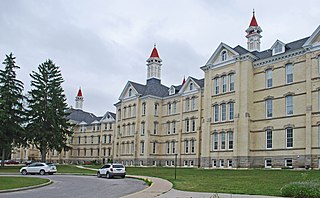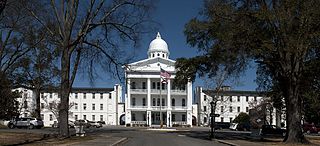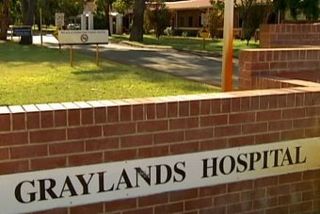
Psychiatric hospitals, also known as mental health units or behavioral health units, are hospitals or wards specializing in the treatment of severe mental disorders, such as schizophrenia, bipolar disorder, and major depressive disorder. Psychiatric hospitals vary widely in their size and grading. Some hospitals may specialize only in short-term or outpatient therapy for low-risk patients. Others may specialize in the temporary or permanent containment of patients who need routine assistance, treatment, or a specialized and controlled environment due to a psychiatric disorder. Patients often choose voluntary commitment, but those whom psychiatrists believe to pose significant danger to themselves or others may be subject to involuntary commitment and involuntary treatment. Psychiatric hospitals may also be called psychiatric wards/units when they are a subunit of a regular hospital.
Piedmont Geriatric Hospital is a geriatric hospital located in the state of Virginia. It is Virginia's only state facility solely dedicated to the evaluation and treatment of persons over the age of 65. The 123-bed geriatric hospital is located in Burkeville on the 300-acre (120 ha) site of the former Piedmont Sanatorium. Founded in 1967, the facility employs 320 staff members and is a training site for major universities, colleges, and vocational schools in geropsychiatry and other clinical specialties.

Bryce Hospital opened in 1861 in Tuscaloosa, Alabama, United States. It is Alabama's oldest and largest inpatient psychiatric facility. First known as the Alabama State Hospital for the Insane and later as the Alabama Insane Hospital, the building is considered an architectural model. The hospital currently houses 268 beds for acute care, treatment and rehabilitation of full-time (committed) patients. The Mary Starke Harper Geriatric Psychiatry Hospital, a separate facility on the same campus, provides an additional 100 beds for inpatient geriatric care. The main facility was added to the National Register of Historic Places in 1977.

Spring Grove Hospital Center, formerly known as Spring Grove State Hospital, is a psychiatric hospital located in the Baltimore, Maryland, suburb of Catonsville.

Greystone Park Psychiatric Hospital referred to both the former psychiatric hospital and the historic building that it occupied in Morris Plains, New Jersey. Built in 1876, the facility was built to alleviate overcrowding at the state's only other "lunatic asylum" located in Trenton, New Jersey. Originally built to accommodate 350 people, the facility, having been expanded several times, reached a high of over 7700 patients resulting in unprecedented overcrowding conditions. In 2008, the facility was ordered to be closed as a result of deteriorating conditions and overcrowding. A new facility was built on the large Greystone campus nearby and bears the same name as the aging facility. Despite considerable public opposition and media attention, demolition of the main Kirkbride building began in April 2014 and was completed by October 2015.
Anoka-Metro Regional Treatment Center (AMRTC), located in Anoka, Minnesota, the county seat of Anoka County, provides inpatient and transitional services to patients with severe mental illness from the Twin Cities metropolitan area . Due to overcrowding, some patients will be transferred to St. Peter's Regional Treatment Center; This is done by random selection upon intake.

The Cherokee Mental Health Institute is a state-run psychiatric facility in Cherokee, Iowa. It opened in 1902 and is under the authority of the Iowa Department of Human Services.
The Institute of Living is a comprehensive psychiatric facility in Hartford, Connecticut, that offers care across the spectrum of psychiatric services, including:
Mendota Mental Health Institute (MMHI) is a public psychiatric hospital in Madison, Wisconsin, United States, operated by the Wisconsin Department of Health Services. The hospital is accredited by the Joint Commission. Portions of the facility are included in the Wisconsin Memorial Hospital Historic District, District #88002183. The Mendota State Hospital Mound Group and Farwell's Point Mound Group are also located at the facility.

Western State Hospital is a psychiatric hospital located at 9601 Steilacoom Boulevard SW in Lakewood, Washington. Administered by the Washington Department of Social and Health Services (DSHS), it is a large facility with 806 beds, and Washington's second-oldest state-owned enterprise.
Atascadero State Hospital, formally known as California Department of State Hospitals- Atascadero (DSHA), is located on the Central Coast of California, in San Luis Obispo County, halfway between Los Angeles and San Francisco. DSHA is an all-male, maximum-security facility, forensic institution that houses mentally ill convicts who have been committed to psychiatric facilities by California's courts. Located on a 700+ acre grounds in the city of Atascadero, California, it is the largest employer in that town. DSHA is not a general purpose public hospital, and the only patients admitted are those that are referred to the hospital by the Superior Court, Board of Prison Terms, or the Department of Corrections.

Cherry Hospital is an inpatient regional referral psychiatric hospital located in Goldsboro, North Carolina, United States. As one of three psychiatric hospitals operated by the North Carolina Department of Health and Human Services, it provides services to 38 counties in the eastern region of North Carolina. It is part of the Division of State Operated Healthcare Facilities within the Department of Health and Human Services, which oversees and manages 14 state-operated healthcare facilities that treat adults and children with mental illness, developmental disabilities, and substance use disorders. The Division's psychiatric hospitals provide comprehensive inpatient mental health services to people with psychiatric illness who cannot be safely treated at a lower level of care.
Sutter Medical Center, Sacramento is a medical center in Sacramento, California that has been named one of the Top 100 Hospitals in the nation for five years, including 2013–2015. It is owned and operated by Sutter Health, a Northern California not-for-profit health system. Sutter Medical Center, Sacramento offers both community-based and tertiary medical services. In 2015, Sutter Medical Center, Sacramento (SMCS) consolidated its Sutter Memorial Hospital campus in East Sacramento with its midtown Sutter General Hospital location, with the opening of the Anderson Lucchetti Women's and Children's Center and the complete remodeling of Sutter General Hospital into the Ose Adams Medical Pavilion. The midtown location is where Sutter Health's first hospital, Sutter Hospital, opened in 1923. Sutter Medical Center, Sacramento also includes Sutter Center for Psychiatry, providing psychiatric, mental health and chemical dependency services since 1958.

Searcy Hospital was a state-owned and operated psychiatric hospital in Mount Vernon, Alabama. It was situated on the grounds of the former Mount Vernon Arsenal, a former United States Army munitions depot dating back to 1828. It closed permanently on October 31, 2012.

Eastern State Hospital is a psychiatric hospital established in 1891 in Medical Lake, a small community 20 miles (32 km) southwest of Spokane, Washington. The original building was a Kirkbride Plan and the current building has a similar floor plan with male and female wings extending out from the main building.

The Utah State Hospital (USH) is a mental hospital located in eastern Provo, Utah, United States of America. The current superintendent is Dallas Earnshaw.

Horton Hospital formerly called Horton Asylum was a large psychiatric hospital in the Horton area of Epsom, Surrey.

Graylands Hospital is Western Australia's largest mental health inpatient facility, and the only public stand-alone psychiatric teaching hospital. It is located on a 10-hectare (25-acre) site in Mount Claremont, in a suburb formerly known as Graylands, after which the hospital was named. The hospital has 178 beds, including 30 beds in the Frankland Centre, and 320 nurses on staff.
Eastern State Hospital, located in Lexington, Kentucky, is the second oldest Psychiatric Hospital in the United States. It operates today as a psychiatric hospital with 239 beds providing inpatient care. Eastern State Hospital is owned by the Commonwealth of Kentucky and falls under the jurisdiction of the Cabinet for Health and Family Services.

The Rockland Psychiatric Center, originally Rockland State Hospital, in Orangeburg, New York is a psychiatric facility for adults operated by the New York State Office of Mental Health. It offers in-patient and transitional treatment for adults, as well as research facilities. There are 13 outpatient facilities and 11 residential programs in the four surrounding counties. The facility shares space with the co-located Nathan Kline Institute. The inpatient treatment center has 410 beds. The current hospital replaces an older hospital on the same 615-acre (249 ha) site.














